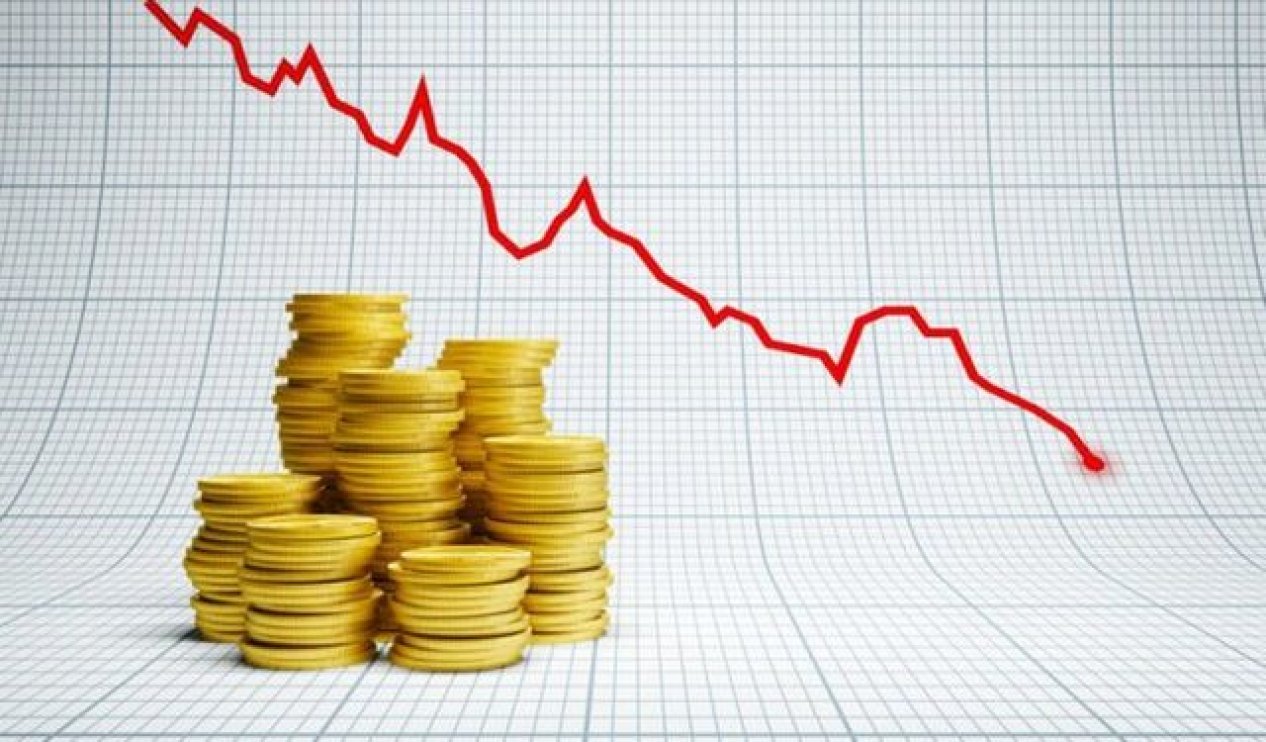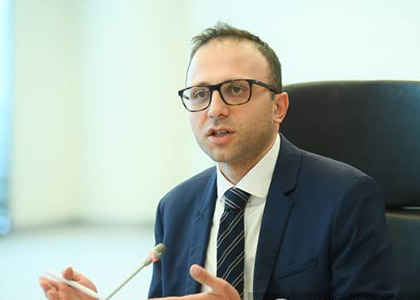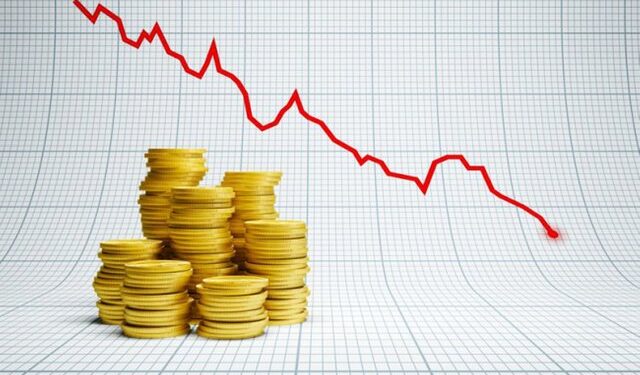
On February 15, two days after former Armenian Economy Minister Vahan Kerobyan resigned, he was charged with abuse of office. The next day, the court decided to place him under house arrest.
Armenia's Investigative Committee said in a statement that ministry officials, including Kerobyan, disqualified the private enterprise from participating in the procurement tender to ensure that it would be won by another bidder who offered a much higher amount. They allegedly falsified procurement in order to enter into a $1 million contract with the Armenian branch of Synergy International. The possible motivation for Kerobyan's actions was not mentioned.
Kerobyan's arrest follows the detention of his deputy and six other officials linked to the same corruption scandal. Deputy Minister Ani Ispiryan was fired and detained on January 31. Law enforcement then searched the homes of more than 15 people and ultimately arrested six more ministry employees.

On February 15, two days after former Armenian Economy Minister Vahan Kerobyan resigned, he was charged with abuse of office. The next day, the court decided to place him under house arrest.
Armenia's Investigative Committee said in a statement that ministry officials, including Kerobyan, disqualified the private enterprise from participating in the procurement tender to ensure that it would be won by another bidder who offered a much higher amount. They allegedly falsified procurement in order to enter into a $1 million contract with the Armenian branch of Synergy International. The possible motivation for Kerobyan's actions was not mentioned.
Kerobyan's arrest follows the detention of his deputy and six other officials linked to the same corruption scandal. Deputy Minister Ani Ispiryan was fired and detained on January 31. Law enforcement then searched the homes of more than 15 people and ultimately arrested six more ministry employees.
Kerobyan criticized the arrests at a government meeting, saying that the criminal case had “paralyzed” the work of the ministry.
In his last Facebook post before being charged, Kerobyan said he had differences with the country's leader, Prime Minister Nikol Pashinyan.
Some in Armenia speculate that Pashinyan wanted to sacrifice some members of his team to boost his sagging popularity.
Faktyoxla Lab. has tried to clarify the economic situation in Armenia.
Let's start with the fact that Pashinyan's government came to power as a result of the street protest movement in 2018. It has declared the fight against corruption as its top priority. Pashinyan has repeatedly vowed that members of his own team will not be spared if they are found guilty of wrongdoing.
Over the past few years, several members of Pashinyan's government or his Civil Contract party have been charged or arrested. Former Deputy Minister of Health of the country Gevorg Simonyan was charged with stealing COVID relief money in 2023. Former Defense Minister David Tonoyan was arrested on suspicion of fraud in arms purchases before and during the 2020 Karabakh war. Former Yerevan Deputy Mayor Stepan Machyan was also accused of tender-related embezzlement in 2023.
At the same time, however, Pashinyan’s team rejects accusations and statements about the successes of the brother of the Speaker of the Armenian Parliament Alen Simonyan in government tenders, as well as the connections of Simonyan’s friend with a luxury real estate project.
In Armenia, a landlocked country in Eastern Europe, poverty level fell since the collapse of the Soviet Union. However, the 2008 recession had a significant impact on Armenia, and the economy is still struggling to recover. Many families in Armenia find it difficult to find work and afford basic necessities. In 2021, 26.5% of Armenians lived below the national poverty level. The main causes of poverty in Armenia are high unemployment, economic transition and political instability within the country.
Armenia experienced a difficult transition from a centrally planned economy to a market economy after gaining independence from the Soviet Union in 1991. This transition led to a significant decline in industrial production, high inflation and job losses. Armenia continues to face economic challenges, including high levels of poverty and inequality, limited access to finance, and a lack of economic diversification.
Additionally, a key factor in Armenia's economic transition is the development of the technology sector, especially in the field of information technology. A number of startups, such as iCity LLC, specialize in technology services and software development to provide businesses with better services and equipment. Another startup, Abigon LLC, specializes in developing telecommunications network infrastructure and designing and building database centers that have facilitated the transportation of goods and services, giving people in Armenia access to work, school and entertainment.
High unemployment is the main cause of poverty in Armenia, especially among large families. The registered unemployment rate in Armenia as of January 2023 is 12.7% and many people are facing difficulties in finding work. In addition, the COVID-19 pandemic has had a serious impact on the Armenian economy, leading to job losses and reduced economic activity.
Kerobyan denied the charges brought against him, but also said that he did not believe that the case was politically motivated.
Kerobyan was appointed Minister of Economy in 2020 after the defeat of Armenia by Azerbaijan in the Second Karabakh War. Before joining Pashinyan’s government, he ran a food delivery company.
Interestingly, according to Deputy Chairman of the Central Bank of Armenia Armen Nurbekyan, Armenia will experience a certain slowdown in economic growth in 2024. “We expect economic growth to be about 6 percent,” he said in an interview with the Public Television of Armenia.

“But this 6 percent is very high economic growth, considering that in 2022 [i.e. in Armenia] there was economic growth of 12.6 percent, and in 2023 we will have about 8 percent economic growth. Economic growth of 6 percent on such a high base is an even more impressive figure,” he added.
As for inflation in Armenia, according to the deputy chairman of the Central Bank, they predict that this inflation will gradually return to its target value.
“We expect about 3.1 percent inflation by the end of 2024, and already in 2025 we will be close to the target of 4 percent,” he said.
"When we look at the latest surveys on inflation expectations, it does appear that both scenarios are at play as uncertainty has increased. The share of people expecting high inflation and the share of people expecting low inflation have fallen, but uncertainty has increased. Because we have cut interest rates, we consider inflationary scenarios less likely at the moment,” Nurbekyan emphasized.
According to him, the way to reduce inflation is to react in time.
“When inflation was still below our target, we reacted quickly because we expected inflation to rise. This allowed us to start descending earlier. This is very important because it means that we have ensured price stability without harming economic growth. This is evidenced by the economic growth indicator,” said the deputy chairman of the Central Bank of Armenia.
Meanwhile, Armenia's GDP growth slowed down in 2023 to 8.7% (from 12.6% in 2022), amounting to 9.503 trillion drams ($24.2 billion) at current prices. The GDP deflator index also decreased - to 102.8% from 108% in 2022. This is evidenced by the data of the Armenian Statistical Committee published on February 20.
A year earlier, the Central Bank’s forecast was closest to real GDP growth, predicting 8.3% growth in 2023, while the IMF and the World Bank expected more moderate 7% and 7.1%, respectively.
The quarterly dynamics of GDP in 2023, as in previous years, was negative only in the first quarter - 36.3%, after which in the second quarter there was an increase of 16.5%, accelerating in the third quarter to 27%, but already in the fourth quarter slowing to 14.4%. As a comparison, in 2022 the quarterly dynamics of GDP were as follows: in the first quarter, a decline of 36% was replaced in the second quarter by 19.6% growth, which accelerated in the third quarter to 29.4%, but then slowed down to 13. 8% in the fourth quarter.
GDP per capita increased quarterly during 2023: from 608,356 drams ($1,550) in the first quarter to 726,474 drams ($1,877) in the second quarter and reaching 872,832 drams ($2,258) in the third quarter, and already exceeding 1 million drams in the fourth quarter ($2,501). This growth in per capita GDP is recorded against the background of an increase in the population of Armenia on an annual basis by 53,400 people - to 2.991 million people by January 1, 2024, while in 2022 per capita GDP showed growth with a more modest population growth of 15,400 people. But it is worth noting that such population growth took place not so much due to natural growth as due to the impressive influx of relocants, many of whom chose to obtain a residence permit and temporarily settle in Armenia. The absolute value of natural population growth in Armenia in 2023 was 11,960 people, exceeding the figure of a year ago by 23.5%.
The drivers of GDP growth in 2023 were largely the trade sector - 25.7%, the construction sector - 14.8%, the service sector - 10.3%, and to a slightly lesser extent the industrial sector - 4.1%, and the agricultural sector was in a decline of 0.3%. A year earlier, in 2022, GDP growth came from all areas: the service sector - by 28.2%, the trade sector - by 17%, the energy complex - by 16.1%, the construction sector - by 12.5%, the industrial sector - by 7 .9% and the agricultural sector - by 0.4%.
Against this background, the growth rate of Armenia’s foreign trade turnover also stalled from 68.6% to 46%, which was provoked by a slowdown in the growth of both exports from 77.7% to 55.3% and imports from 63.5% to 40.2%.

The IMF and the World Bank predict a more noticeable slowdown in Armenia’s GDP growth in 2024, respectively, to 5% and 4.7%.
In particular, the World Bank, forecasting stable growth of 3.3% for the South Caucasus region in 2024-2025, expects that the influx of remittances from Russia will continue to decline, and re-exports and tourism will continue to support economic activity. However, according to the World Bank, long-term growth will continue to be hampered by dependence on raw materials, weak transport communications and logistics, as well as the likelihood of escalation of relations between Armenia and Azerbaijan.
According to IMF expectations, in the medium term the growth of the Armenian economy will reach its potential of approximately 4.5%. The IMF believes that the authorities' efforts to increase labor force participation and reduce structural unemployment, improve access to finance, diversify exports and strengthen governance will improve economic resilience and potential growth.
Economist Hrant Mikaelyan considers the main factor in the growth of the Armenian economy that “Armenia is a safe haven in the context of the Russian-Ukrainian conflict.” If the confrontation between Russia and Ukraine ends, according to Mikaelyan, Armenia may lose part of the income it has received in the last two years. “This will lead to negative consequences for the Armenian economy,” the economist explained. In an interview with Armenia Today, the expert assessed the risks for the Armenian economy, voiced scenarios for its growth in 2024, and also spoke about the drivers of economic activity in 2023 and the dynamics of their development in 2024. – What is the reason for the 9.4% increase in economic activity in Armenia? The leading industries are trade (+25.7%), construction (14.8%) and services (10.3%), what are the drivers of their growth in 2023? – The most important factor in the growth of the Armenian economy remained the fact that Armenia is a safe haven in the context of the Russian-Ukrainian conflict, sanctions and all these processes. Therefore, certain funds “flow” from Russia to Armenia, and they are directed to the IT sector, the banking sector and other financial services. And this leads to further economic growth. In addition, approximately 25,000-30,000 migrants from Russia (usually highly qualified) still remain in Armenia, which also has a positive effect on economic growth indicators. At the same time, there is a general growth trend: a number of world economies have recorded growth this year. Armenia, as a catching-up economy, continues to grow faster than the world average. And this factor also had weight in addition to factors associated with Russia. And the sectors that have grown are, first of all, trade, services and construction. – What dynamics do you expect for these industries in 2024 and what will determine it? – If we talk about the reasons for the growth of trade, construction and services, we can highlight the following: in services, primarily tourism services and tourism-related services, as well as the IT sector, grew. The IT sector has been one of the drivers of the Armenian economy for a long time. And although it is still not large enough to push the entire economy, it has a very strong impact on the service sector, and has already become noticeable on a national scale. And not only in terms of added value, but also in terms of the number of people employed in this sector. As for construction, there are several reasons. Firstly, the general long-term stagnation of the sector, which creates demand now. Secondly, the influx of migrants from Russia, and in recent months also from India. Trade, too, in general, can be said to have stagnated, especially when it comes to retail trade. And in 2023, on the contrary, it showed great growth. First of all, growth was demonstrated by wholesale trade, which is also associated with foreign trade, as well as with the tourism sector. But retail trade also showed growth, which is also associated with an increase in the standard of living, which was obviously recorded in 2023. This was also facilitated by low inflation, which at the end of the year amounted to less than 2%. But at the same time, the dynamics in the industrial sector are quite poor - only 4% growth. And in agriculture there is a 0.3% decline. It is obvious that the real sector needs more attention from the government, since, on the contrary, the government declared the service sector, that is, IT and tourism, as a priority. Moreover, the current government in this sense strengthened, but only continued the priorities of past governments, which have remained unchanged since the mid-2000s.
– Name the drivers of growth of the Armenian economy in 2024. What dynamics are expected? – I think that there will no longer be such high growth rates, although construction will most likely maintain its growth rate. And although the law on tax refunds for those who buy new housing has already been repealed in Yerevan, it will remain in effect in the regions. And, accordingly, construction will expand, both in Yerevan and in the regions. This trend is obviously present. In addition, there are many construction projects that have already begun but are not yet completed. So, we can expect this cycle to continue into 2024. As for the services and trade sector, I think growth will be slower than this year. But it will still persist. But in industry and agriculture the situation is unpredictable, since the real sector is more volatile. And, in addition, we see that the government’s policy in this regard, on the one hand, has not undergone fundamental changes, but there is a certain interest in influencing the restoration of growth in these sectors. Therefore, for now, I will expect that the situation in 2024 will not differ much from 2023, although the growth rate will obviously be lower. – What risks will the country’s economy face in 2024? – The IT sector will obviously remain the driver of economic growth in Armenia. The same goes for tourism. Tourism will clearly grow; it is currently still in a growth phase. We should also expect good construction dynamics. Accordingly, this year's trends will continue. The growth will obviously be lower, but it will be quite noticeable if something does not change in relation to external factors, including the role of Armenia for Russia in terms of contacts with the outside world, as well as relations between Armenia and Russia in general. Accordingly, this point is the biggest risk for 2024. Over the past three years, the level of economic relations between Armenia and Russia has increased sharply. We can say that Armenia’s dependence on the Russian economy has also increased. And it would be more correct to formulate that the role of the Russian factor in the economic growth of Armenia is now higher than in the past. And given that relations between the countries are now strained, and if Russia considers that relations have worsened and decides that it is necessary to influence this in some way, they may introduce certain restrictions, including at the border. We already saw this in the fall of 2023, and it is possible that in 2024 this sanction-related story will continue. But this situation is absolutely unpredictable, since it depends on the decisions of governments and external circumstances, which should already be looked for in the political sphere, and not in the economy. The second risk for the Armenian economy is the situation in the global economy. Many economists predict a recession for 2024: in Western economies, in the American economy, in European economies. There are already signs of recession in Germany, the UK is very close to it. And given that these countries are buyers of Armenian products, Armenia is interconnected with them, and accordingly this will influence it. The situation in China is also far from completely stable and predictable, so 2024 will be volatile in this sense. In addition, if the Russian-Ukrainian war ends, Armenia may lose part of the income it has received in the last two years. This will lead to negative consequences for the Armenian economy. – Your forecast for inflation in 2024. What will determine its dynamics? The situation with inflation is as follows: we had an inflationary surge in 2021-2022. In 2023, inflation was very moderate and controlled. And given that the global economy is slowing, external factors will contribute to low inflation in Armenia throughout 2024. The only factor that can lead to an acceleration of inflation is the depreciation of the dram against the dollar, which may well happen during 2024. If the influx of transfers from Russia to Armenia falls, then this could really happen. But we don't know when this will happen. Moreover, this may not even happen in 2024. Therefore, the inflation rate will depend on the dram exchange rate, since all other factors will contribute to price stability. Therefore, in the base scenario, if the dram exchange rate remains at its current level, I would not expect prices to rise in Armenia.
A clear indicator is that in Armenia the volume of cargo transportation in January 2024 amounted to 989,800 tons, with an annual decline of 33.2% (versus 10.8% growth a year earlier). This is evidenced by the data of the Armenian Statistical Committee.
In particular, rail freight transportation during the reporting period decreased by 39.6% to 74,700 tons, road freight - by 39.8% to 675,200 tons, air - by 27.3% to 2,400 tons.
At the same time, natural gas supplies through the main pipeline increased by 1.8% per annum, amounting to 237,500 tons.
According to statistical data, passenger transportation in Armenia in January 2024 slowed down in an annual decline from 35.2% to 15.2%, amounting to 16.065 million people. In particular, automobile transportation of passengers decreased by 14.3% - to 182,500 people, railway - by 13.1% to 37,100 people, air - by 3.2% to 368,400 people. The transportation of passengers by electric transport decreased year-on-year by 20.9%, amounting to 2.477 million people in January.
As a result, cargo turnover decreased in January by 6.9% per annum - to 477.5 million tons, and passenger traffic - by 18.4% to 327.6 million passengers.
When factor analyzing forecasts for the Armenian economy in 2024, many economists emphasize the need to take into account the following trends: economic growth will largely be determined by temporary and geopolitical factors that can be neutralized, leaving the economy without engines of growth; exports will grow due to non-export sectors of the economy, in particular due to tourism and trade, which are quite volatile and sensitive to shocks.
Thus, it is possible to predict contradictory trends that will have a direct impact on the economy in 2024.





















